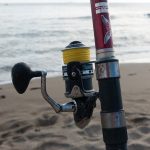Can You Use Yellow Fishing Line For Saltwater Fishing?
The reason for using yellow fishing line it to be able to see the line better to detect bites. The bright color is easy to see for the angler, but the negative is it is also easy for the fish to see.
Fishing lines come in different colors, including yellow, and it is common for anglers to wonder whether they can use yellow fishing line for saltwater fishing. The short answer is yes, you can use yellow fishing line for saltwater fishing, but there are some considerations to keep in mind.
In this article, we will discuss the advantages and disadvantages of using yellow fishing line for saltwater fishing and provide some tips to help you make the most of your fishing experience.
Advantages of Using Yellow Fishing Line for Saltwater Fishing
- High Visibility
One of the main advantages of using yellow fishing line for saltwater fishing is its high visibility. This can be particularly useful when fishing in murky or cloudy water, as it makes it easier to see where your line is and to detect bites.
Yellow fishing line can also be useful for fishing in low light conditions, such as dawn or dusk, as it is easier to see than other colors. This can help you to detect bites more quickly and to react more effectively.
- Durable
Yellow fishing line is typically made from strong materials, such as braided or fluorocarbon line, which can be more durable than other types of fishing line. This is important when fishing in saltwater, as salt can be corrosive and can cause damage to fishing lines over time.
- Versatile
Yellow fishing line can be used for a wide range of saltwater fishing applications, including surf fishing, pier fishing, and offshore fishing. This versatility makes it a good choice for anglers who like to switch between different types of fishing, or who fish in different locations.
Disadvantages of Using Yellow Fishing Line for Saltwater Fishing
- Increased Visibility to Fish
While high visibility can be an advantage when fishing in murky or cloudy water, it can also be a disadvantage when fishing in clear water. In clear water, fish can see the line more easily, which can make them more wary and less likely to bite.
This is particularly true for fish that are known for being cautious, such as bonefish or permit. In these cases, using a more subtle color, such as clear or green, may be a better option.
- Potential Spooking of Fish
In addition to increased visibility, yellow fishing line can also spook some fish. This is because yellow is a bright and unnatural color in the water and can be seen by some fish as a warning signal.
This is particularly true for fish that are easily spooked, such as trout or bonefish. In these cases, using a more natural color, such as green or brown, may be a better option.
- Heat Absorption
Yellow fishing line can absorb more heat than other colors, which can cause it to weaken or break more easily. This is particularly true for braided line, which is made from synthetic fibers that can be sensitive to heat.
When fishing in hot or sunny conditions, it is important to keep your line out of direct sunlight and to use a cooler or shade if possible. This can help to prevent heat damage and prolong the life of your fishing line.
Tips for Using Yellow Fishing Line for Saltwater Fishing
- Match the Color to the Conditions
When using yellow fishing line for saltwater fishing, it is important to match the color to the conditions. In murky or cloudy water, yellow can be a good choice, as it is more visible and can help you detect bites more easily.
In clear water, however, it may be better to use a more subtle color, such as green or brown, to avoid spooking fish.
- Use a Fluorocarbon Leader
To reduce the visibility of your line, you can use a fluorocarbon leader in clear water. Fluorocarbon line is virtually invisible in the water and can help to reduce the chances of spooking fish.
By using a yellow fishing line with a fluorocarbon leader, you can take advantage of the high visibility of the yellow line while also minimizing its potential drawbacks.
- Keep the Line Cool
To prevent heat damage to your yellow fishing line, it is important to keep it out of direct sunlight and to use a cooler or shade if possible. This can help to prevent the line from weakening or breaking, which can result in lost fish.
- Change the Line Regularly
Regardless of the color of your fishing line, it is important to change it regularly. Over time, fishing line can become weakened or damaged, which can compromise its strength and effectiveness.
By changing your yellow fishing line regularly, you can ensure that it is always in good condition and ready for your next fishing adventure.
Conclusion
In summary, using yellow fishing line for saltwater fishing can have both advantages and disadvantages. While yellow line is highly visible and versatile, it can also be more easily seen by fish and can absorb more heat than other colors.
By keeping these factors in mind and using some of the tips outlined in this article, you can make the most of your yellow fishing line and increase your chances of success on the water. Ultimately, the best fishing line color for saltwater fishing will depend on the specific conditions and the preferences of the angler.






